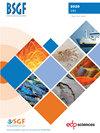Deep controls on foreland basin system evolution along the Sicilian fold and thrust belt
IF 2.6
3区 地球科学
Q2 GEOSCIENCES, MULTIDISCIPLINARY
引用次数: 48
Abstract
Neogene-Quaternary wedge-top-basins arose during the Sicilian fold and thrust belt (FTB) build-up. The infilling sedimentary successions are: i) middle-upper Miocene silicoclastics succession, accommodated on top of the accreted Sicilide and Numidian flysch nappes; ii) upper Miocene-lower Pliocene deepening-upwards sediments unconformably overlying the inner Meso-Cenozoic deep-water, Imerese and Sicanian thrust units; iii) Upper Pliocene-Quaternary coastal-open shelf deposits unconformably covering (in the outer sector of the FTB) a tectonic stack (Gela thrust system). These successions are characterized by a basal unconformity on the deformed substrate believed to be the depositional interface common both to the coeval wedge-top and foredeep basins. The tectono-sedimentary evolution of the syn-tectonic basins was controlled by the progressive deepening of the structural levels, which were active during the growing of the FTB. The palinspastic restoration of a crustal geological transect in central Sicily points to: i) the occurrence of two subsequent, basal main thrusts (MT1 and MT2) active during the Neogene-middle Pleistocene tectonic evolution, as well as ii) a decrease in slip- and shortening-rate, estimated for the later MT2 as compared to earlier MT1 basal main thrust. The foreland-basin system evolution recorded during these two steps suggests: – the regional lithofacies distribution, during late Tortonian-early Pliocene, accounted for a wide depozone including the Iblean plateau and its offshore;– a crucial change was recorded by the late Pliocene-Pleistocene wedge-top depozone, when the deeper basal main thrust (MT2) involved and thickened (in the inner sector of the FTB) the crystalline basement (thin- to thick-skinned thrust tectonics); this change influenced the depozones, progressively narrowing up to the present-day setting. As regards this general evolutionary framework, thin-skinned and thick-skinned thrust tectonics can be recognized in the Sicilian FTB evolution. The late Tortonian-early Pliocene, thin-skinned thrust tectonics include two main tectonic events, a “shallow-seated” Event 1 and a “deep-seated” Event 2, with the Pliocene-Pleistocene thick-skinned thrust tectonics representing a third tectonic event (Event 3).西西里褶皱冲断带前陆盆地体系演化的深层控制因素
新近系—第四纪楔顶盆地是在西西里褶皱冲断带(FTB)构造过程中形成的。充填沉积序列为:ⅰ)中-上中新世硅屑序列,发育在硅屑和努米底复理推覆构造之上;ii)上中新世-下上新世上深向上沉积不整合覆于内中新生代深水、伊日耳斯和西西里逆冲单元上;iii)上新世—第四纪海岸—开放陆架沉积不整合覆盖构造叠层(盖拉逆冲体系)。这些序列的特征是在变形基底上的基底不整合,被认为是同时期楔顶盆地和前深盆地共同的沉积界面。同构造盆地的构造-沉积演化受构造水平的逐渐加深控制,构造水平在下伏构造带生长期间活跃。西西里岛中部一个地壳地质样带的原始恢复表明:1)在新第三纪-中更新世构造演化期间,出现了两个后续的基底主逆冲(MT1和MT2),以及2)与早期MT1基底主逆冲相比,估计MT2后期的滑动和缩短速率有所降低。这两个阶段记录的前陆-盆地体系演化表明:—晚托尔东—上新世早期的区域岩相分布,形成了包括伊布尔高原及其近海在内的广泛的沉积带;—晚上新世—更新世楔顶沉积带发生了关键性的变化,较深的基底主逆冲(MT2)介入并加厚了结晶基底(薄皮至厚皮逆冲构造);这种变化影响了沉积带,逐渐缩小到今天的环境。在这一总体演化格局下,西西里构造演化可分为薄皮逆冲构造和厚皮逆冲构造。晚托尔东—上新世早期,薄皮逆冲构造包括两个主要的构造事件,即“浅地”事件1和“深地”事件2,上新世—更新世厚皮逆冲构造代表第三个构造事件(事件3)。
本文章由计算机程序翻译,如有差异,请以英文原文为准。
求助全文
约1分钟内获得全文
求助全文
来源期刊
CiteScore
5.80
自引率
0.00%
发文量
18
审稿时长
>12 weeks
期刊介绍:
BSGF - Earth Sciences Bulletin publie plusieurs types de contributions :
1. des articles originaux, couvrant tous les champs disciplinaires des Géosciences, à vocation fondamentale mais également à vocation plus appliquée (risques, ressources);
2. des articles de synthèse, faisant le point sur les avancées dans un domaine spécifique des Géosciences, qu''elles soient méthodologiques ou régionales ;
3. des monographies sur la géologie d’une région donnée, assorties d’informations supplémentaires, cartes, coupes, logs, profils sismiques … publiées en ligne en annexe de l’article ;
4. des articles courts de type « express letter » ;
5. des livrets-guides d’excursion (qui suivront le même processus d’examen éditorial que les articles plus classiques) ;
6. des comptes rendus de campagnes à la mer ;
7. des articles de données géodésiques, géophysiques ou géochimiques, pouvant devenir des articles de référence pouvant conduire à des interprétations ultérieures.
BSGF - Earth Sciences Bulletin constitue également un forum pour les discussions entre spécialistes des Sciences de la Terre, de type comment-reply ou autre. Tous les articles publiés, quelle que soit leur forme, seront accessibles sans frais (articles en Open Access) sur le site de la SGF et sur celui de Geosciences World dans la mesure où les auteurs se seront acquittés d’une contribution de (Article Processing Charges – APC) de 300€ pour les membres de la SGF et 500€ pour les non-membres.

 求助内容:
求助内容: 应助结果提醒方式:
应助结果提醒方式:


